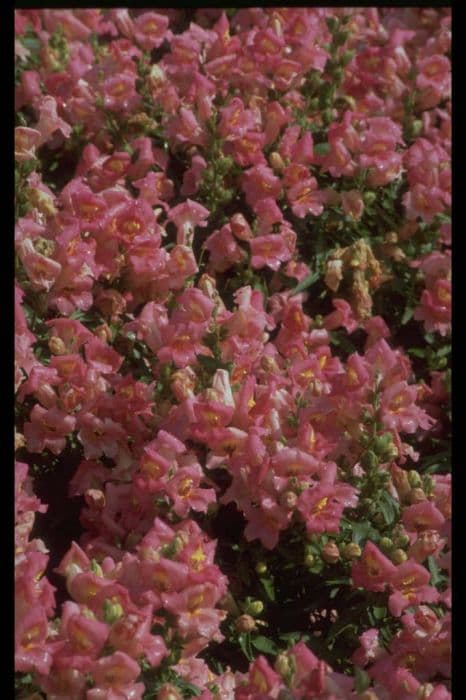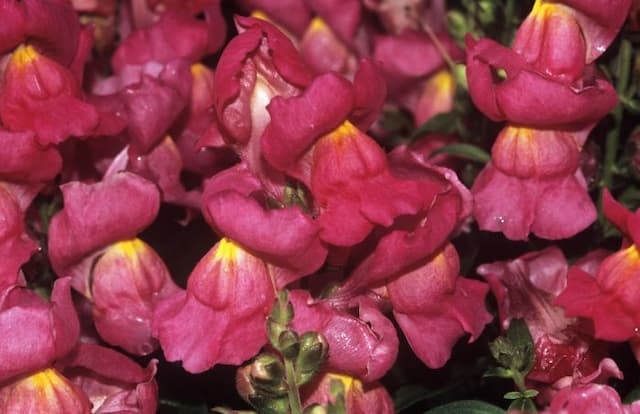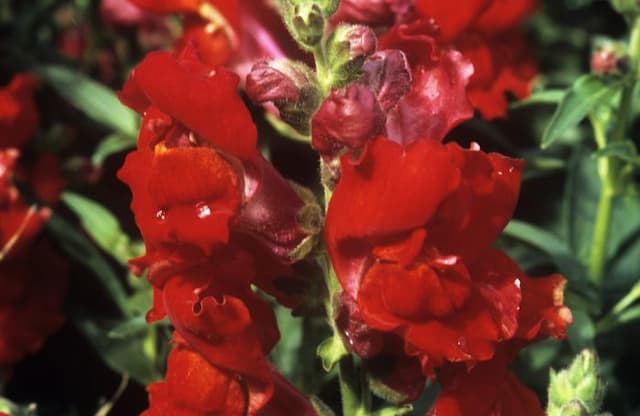Hebe Caledonia Hebe 'Caledonia'

ABOUT
Hebe 'Caledonia' is a bushy, evergreen shrub known for its striking foliage and flowers. The leaves of 'Caledonia' have a deep, glossy green hue and are spear-shaped with a slightly rounded tip. They are arranged oppositely along the stems, creating a dense, lush appearance. During the flowering season, the plant bears a profusion of blooms that cluster at the tips of the stems. These flowers are generally a dark pink to purple color, which adds a vibrant contrast against the rich green of the leaves. As the blooms age, they often fade to a lighter shade, providing a beautiful two-toned effect. Overall, this plant has a neat, compact appearance that is attractive in a variety of garden settings.
About this plant
 Names
NamesFamily
Plantaginaceae.
Synonyms
Caledonia Hebe, Veronica 'Caledonia'.
Common names
Hebe 'Caledonia'.
 Toxicity
ToxicityTo humans
Hebe 'Caledonia', generally known as Hebe, has not been widely reported to be toxic to humans. However, as with any plant, some people may have skin reactions or allergies upon contact. Ingestion is typically not a major concern with Hebes, but as a precaution, they should not be consumed, and children should be taught not to eat any plant material. If ingested, in rare cases, it might cause mild stomach upset. If symptoms appear after ingestion or contact, it is advisable to seek medical attention.
To pets
Hebe 'Caledonia', or Hebe, is not commonly listed as a toxic plant to pets such as dogs and cats. It is generally considered to be of low toxicity and does not pose a significant risk. However, ingestion of any plant material can potentially cause mild gastrointestinal upset in some pets. If a pet consumes a large portion of the plant and has symptoms such as vomiting or diarrhea, it is recommended to consult a veterinarian.
 Characteristics
CharacteristicsLife cycle
Perennials
Foliage type
Evergreen
Color of leaves
Varies
Flower color
Purple
Height
2 feet 24 inches (60 cm)
Spread
2 feet 24 inches (60 cm)
Plant type
Shrub
Hardiness zones
7
Native area
New Zealand
Benefits
 General Benefits
General Benefits- Easy to Grow: Hebe 'Caledonia' is known for being a low-maintenance plant that is relatively easy to grow in a variety of conditions.
- Drought Tolerant: Once established, it is quite drought-tolerant, making it suitable for gardens in drier climates or for gardeners who prefer plants that don't require constant watering.
- Attracts Wildlife: The flowers of Hebe 'Caledonia' can attract beneficial insects such as bees and butterflies, promoting biodiversity in the garden.
- Evergreen Foliage: It provides year-round interest with its evergreen foliage, adding color and texture to the garden even in winter months.
- Compact Size: With its compact growth habit, this plant is suitable for small gardens, containers, and as a border plant.
- Floral Display: Hebe 'Caledonia' produces attractive deep purple or violet flowers that can enhance the aesthetic appeal of any garden space.
- Versatility: It can be used in various garden designs, including rock gardens, coastal gardens, and as part of mixed borders.
- Low Pruning Requirement: This plant typically requires minimal pruning, helping to reduce garden maintenance time.
 Medical Properties
Medical PropertiesThis plant is not used for medical purposes.
 Air-purifying Qualities
Air-purifying QualitiesThis plant is not specifically known for air purifying qualities.
 Other Uses
Other Uses- Hebe 'Caledonia' can be used as a natural dye source; the leaves may produce a variety of subtle colors when used in the dyeing of fabrics or yarns.
- These shrubs can act as privacy screens when planted in groups, providing a dense, evergreen barrier in gardens or around patios.
- Hebe 'Caledonia' branches can be used in floral arrangements, adding an interesting texture and foliage contrast to cut flowers.
- They can be planted in coastal areas as they are tolerant to sea spray and can help in stabilizing slopes and banks.
- Crushed leaves of Hebe 'Caledonia' can act as a natural insect repellent when spread around outdoor seating areas.
- The dense habit and foliage of Hebe 'Caledonia' can provide a habitat and protection for small garden fauna like birds and beneficial insects.
- These plants can be used as a living mulch; their spreading nature can cover the ground, helping to retain soil moisture and suppress weeds.
- Hebe 'Caledonia' can work as a visual indicator of the changing seasons, as its foliage and flowers change throughout the year, signaling gardeners to seasonal tasks.
- The leaves can be used as bookmarks, especially when flattened and dried, adding a touch of greenery and a pleasant, natural aroma to reading material.
- Hebe 'Caledonia' can act as a natural windbreak when planted in rows, reducing wind speed in exposed gardens or terraces.
Interesting Facts
 Feng Shui
Feng ShuiThe Hebe plant is not used in Feng Shui practice.
 Zodiac Sign Compitability
Zodiac Sign CompitabilityThe Hebe plant is not used in astrology practice.
 Plant Symbolism
Plant Symbolism- Youthfulness: Hebe is the goddess of youth in Greek mythology, and plants named after her, like 'Caledonia', are often associated with youth and rejuvenation.
- Everlasting Love: Given its evergreen nature, Hebe 'Caledonia' symbolizes love that endures through all seasons and conditions.
- Unity: With its compact growth habit and the way its flowers cluster together, this plant can represent the unity and togetherness in relationships.
- Protection: Hebe 'Caledonia' might also be associated with protection, as many people plant Hebes near their homes for their full and lush foliage.
 Water
WaterThe Hebe 'Caledonia', commonly known as Caledonia Hebe, thrives when watered regularly but it’s important to let the soil dry out slightly between waterings. During the growing season in spring and summer, water the plants thoroughly once a week, using roughly half a gallon for smaller shrubs and up to 2 gallons for larger ones, depending on the plant size and the weather conditions. During the dormant season in fall and winter, reduce watering frequency to every other week, adjusting for rainfall. Avoid overwatering, as Caledonia Hebe does not like waterlogged conditions.
 Light
LightCaledonia Hebe prefers a location that offers full sun to partial shade. Full sun encourages the best flowering and foliage density, but in particularly hot climates, some afternoon shade will help protect the plant from excessive heat. A spot that receives at least 6 hours of direct sunlight a day is ideal for this shrub.
 Temperature
TemperatureCaledonia Hebe does well in a range of temperatures and can tolerate a minimum temperature of around 20°F. The ideal growing temperature is between 60°F and 70°F. This plant may not survive extended periods of temperatures below 20°F or sudden, severe cold snaps, so provide protection or consider container growing in regions where temperatures fall outside these ranges.
 Pruning
PruningPruning Caledonia Hebe is mainly to maintain shape and encourage bushier growth. Prune in the early spring or immediately after the plant has finished flowering. Cut back up to one-third of the old growth to promote new shoots. Deadheading spent flowers will also encourage a second bloom. Regular pruning every year or two is generally sufficient for keeping the plant looking its best.
 Cleaning
CleaningAs needed
 Soil
SoilHebe 'Caledonia', commonly referred to as simply Hebe, thrives best in a soil mix that is well-draining and rich in organic matter. A mixture containing two parts peat, one part perlite, and one part compost works well, ensuring both drainage and fertility. The ideal soil pH for Hebe should be slightly acidic to neutral, in the range of 6.0 to 7.0.
 Repotting
RepottingHebes, including Hebe 'Caledonia', do not require frequent repotting and can be repotted every 2-3 years. Young plants may benefit from annual repotting, while mature plants can be left longer unless they are root-bound or the soil is depleted.
 Humidity & Misting
Humidity & MistingHebe 'Caledonia' prefers a moderate to high humidity level, but is fairly adaptable to different humidity conditions. Aiming for a humidity level of 50-60% is generally conducive to healthy growth.
 Suitable locations
Suitable locationsIndoor
Provide bright indirect light, well-draining soil, and water thoroughly.
Outdoor
Plant in well-draining soil, full sun to partial shade, shelter from strong winds.
Hardiness zone
7-10 USDA
 Life cycle
Life cycleHebe 'Caledonia', also known as Caledonia hebe, begins its life cycle when seeds are sown or cuttings are planted in well-draining soil in the spring. The seeds germinate and cuttings take root, developing into young plants, which then undergo a period of vegetative growth, forming a compact shrub with glossy, evergreen leaves. During the summer months, Caledonia hebe enters its reproductive phase, producing spikes of purple or violet flowers that attract pollinators and may set seed if conditions are favorable. After flowering, the plant goes into a dormant phase in the colder months, although as an evergreen, it retains its foliage. With proper care, which includes pruning to encourage a bushy growth habit and to remove dead flowers, Hebe 'Caledonia' can live for several years. As the plant ages, it can become woody and may lose vigor, at which point it is often replaced in the garden.
 Propogation
PropogationPropogation time
Spring-Summer
The Hebe 'Caledonia' is most commonly propagated by semi-ripe cuttings. The ideal time to take these cuttings is during late summer to early autumn. To propagate by this method, select healthy growth from the current year and cut a section approximately 4 to 6 inches (10 to 15 centimeters) in length. Strip the lower leaves and dip the base of the cutting into rooting hormone powder to encourage root development. Then, insert the cutting into a pot filled with a mixture of peat and perlite or a similar well-draining rooting medium. Place the pot in a warm, shaded area and keep the medium consistently moist but not waterlogged. Roots should develop within a few weeks, after which the plant can be gradually acclimatized to normal conditions and eventually transplanted outdoors.









